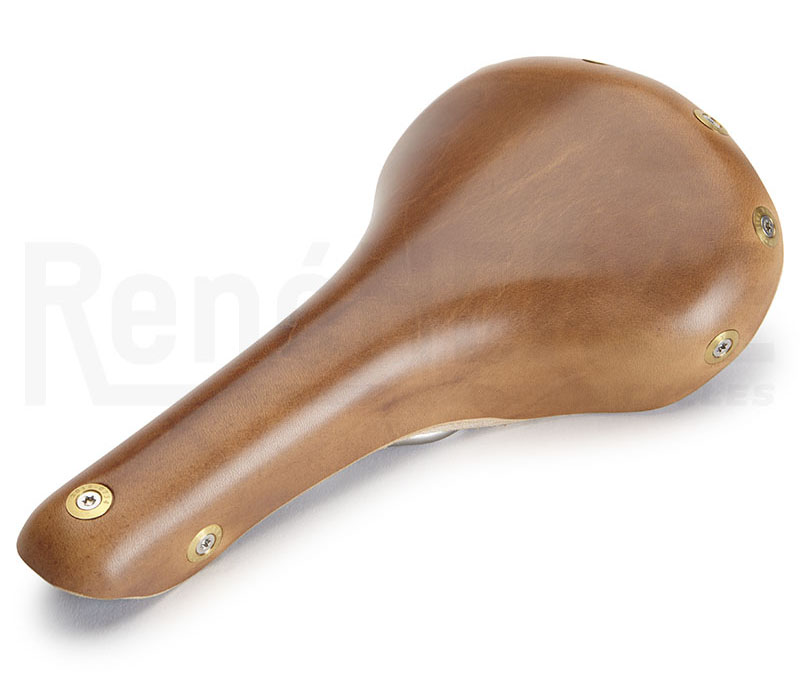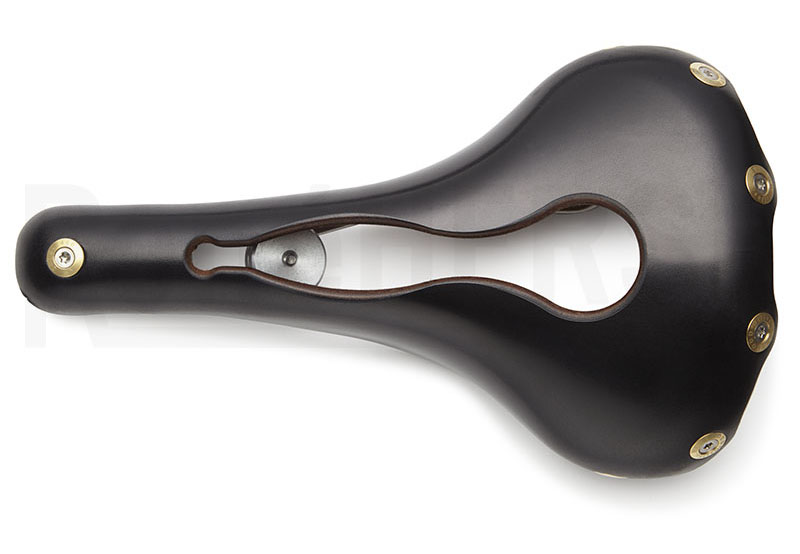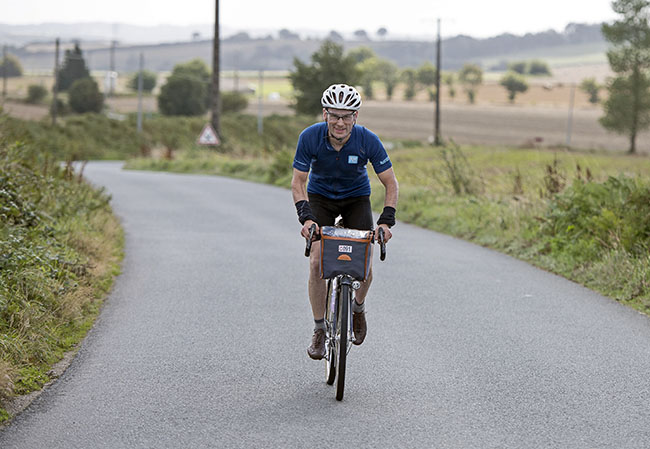Contact Points Matter: Saddles

When I built my new bike for this year’s Paris-Brest-Paris, I was reminded of professional racers in the old days, who brought their favorite saddle and handlebars to the builder of their new bike. I’ve talked about handlebars here; today, I’ll cover saddles as the second contact point between us and our bikes.
For my new bike, I did what the pros used to do: I installed my favorite saddle, which has moved from one Bicycle Quarterly test bike to the next. It’s well-worn, which is why it is so comfortable: I had no saddle issues during the 56:35 hours of Paris-Brest-Paris.
Leather saddles change their shape over time: They conform to your anatomy as you ride. In my case, two dimples form where my sitbones go (above). Plastic saddles don’t have these indentations (or whatever your anatomy requires), so they use foam that temporarily conforms to your body’s shape. But the foam always pushes back, which creates pressure points that can cause pain, abrasions and saddle sores.

If you ride super-fast and only for relatively short periods, you barely touch your saddle, and most saddles will work fine. Once distances get longer, even the fastest racers care about their saddles. Ted King has been riding a Berthoud saddle in events like the 200-mile Dirty Kanza (above). He called it the “most comfortable saddle I’ve ever ridden.”

We started importing Berthoud saddles because we agree with Ted: Even among leather saddles, the Berthouds stand out for their comfort and quality. Not only is the leather absolutely top-notch, but the composite frame flexes a little, which improves the comfort further. (The metal frames of traditional leather saddles are unyielding and stiff.)
Berthoud saddles are available with a choice of stainless steel or titanium rails. The ti rails don’t just save weight: They are more flexible, making the saddles even more comfortable. Choosing your saddle is only partially about your body shape. More important is your riding style: When you pedal hard and your back is inclined at a low angle, you hardly touch the saddle, and you need a narrow saddle that fits between your legs. If you are riding longer distances and sit more upright, you put more weight on your sitbones, and you need a (slightly) wider saddle.

New in the Rene Herse program is the Soulor (above), which combines the minimalist, narrow shape of the superlight Galibier with more affordable stainless steel rails. Both the Soulor and the Galibier are a great choice for spirited riding. I’ve used the Galibier on a number of BQ test bikes, as well as the Concours de Machines J. P. Weigle.

For long rides, I prefer the Aravis (titanium rails) and Aspin (stainless), which have a slightly wider back and taller flanks that hold their shape a little better. That is the saddle I use on my new bike: Being comfortable is key for putting out power and riding fast.

The Agnel (titanium) and Marie-Blanque (stainless) are women’s saddles with shorter noses. However, some women prefer the standard Aravis/Aspin, since their longer rails offer better shock absorption. (The shorter nose of women’s saddles apparently was introduced to allow riding in skirts…)

Berthoud’s ‘Open’ models have a cutout that relieves pressure. For riders who suffer from saddle problems in this area, the ‘Open’ saddles are a great choice. (For me, both styles work equally well.)

Many customers ask how long it takes to break in a Berthoud saddle. This depends mostly on how old the leather is. If the saddle was made years ago and has been lying in a warehouse ever since, the leather will have dried out, and the break-in period will be much longer. When you hear stories of leather saddles taking forever to break in, they usually came from such old stocks.
 We order our Berthoud saddles in small batches, so you are certain to get a fresh saddle. In my experience, it takes 150-200 miles (240-320 km) for a standard Berthoud saddle to become comfortable. The saddle will continue to improve over the following 500 or so miles (800 km). At that point, its condition will stabilize, and it will last many years. The ‘Open’ saddles are more flexible and break in more quickly.
We order our Berthoud saddles in small batches, so you are certain to get a fresh saddle. In my experience, it takes 150-200 miles (240-320 km) for a standard Berthoud saddle to become comfortable. The saddle will continue to improve over the following 500 or so miles (800 km). At that point, its condition will stabilize, and it will last many years. The ‘Open’ saddles are more flexible and break in more quickly.
Don’t try to speed the break-in period by applying neatsfoot oil or other products that soften the leather by breaking down its fibers.

If you want to soften the leather a bit, you can apply Obenauf’s leather preservative (above), which uses beeswax and natural propolis to soften the leather without damaging its fibers. Obenauf’s also great for keeping your leather saddle in perfect shape for many years.

How long does a Berthoud saddle last? I am still riding one of the prototype saddles that Berthoud made in 2007. It’s on my Urban Bike (above) that sees year-round use in rainy Seattle. The saddle on my new Herse has been through many adventures, too, yet it was supremely comfortable during the 1200 km (765 miles) of last month’s Paris-Brest-Paris.

And if your saddle does wear out eventually, it’s easy to replace the leather top. We have all replacement tops in stock, and you just need a Torx wrench to take off the old top and install a new one. All other spare parts are available as well, so your Berthoud saddle is fully rebuildable.

But really, you have to ride a Berthoud saddle to understand why we like them so much!
Click here for more information about Berthoud saddles.
Photo credits: Ansel Dickey (Photo 2), Nicholas Joly (Photos 8, 13).


